BSA’s Bantam is everywhere in trials today, but how did it all begin? Tim Britton takes a look back at the early days.
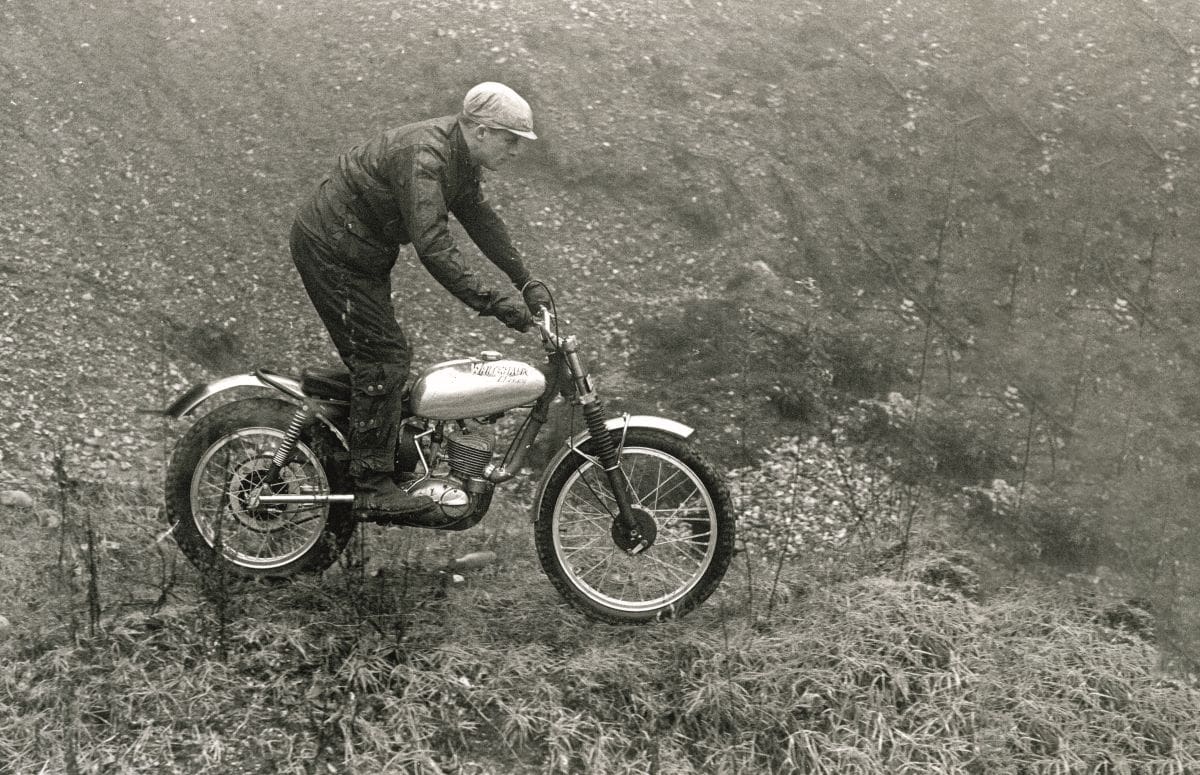
Words: Tim Britton Media Ltd Pics: Mortons Archive
If the aim is to produce a light comp bike it makes sense to start with a bike already light… doesn’t it?
It is probably safe to assume the Bantam has far exceeded any expectations BSA ever had for it when it joined their range in 1948. Probably the company initially viewed it as an entry level machine to capture new riders and gain marque loyalty. Since those far-off days when BSA obtained the two-stroke’s design from DKW as part of war reparations and produced their version of the German machine it has gone on to capture the hearts of a motorcycling public. With the twin attributes of being uncomplicated and simple in operation added to its light weight, the Bantam has served the Post Office as a telegram delivery mount, helped district nurses on their rounds, been the chosen mount for world travellers and made its mark in all manner of motorcycle sporting disciplines.
Though BSA introduced a ‘competition’ version of the D1 Bantam in 1949 it is doubtful the company ever thought it would be a serious contender in any sort of competition. This competition version was little different from the roadster, as indeed most comp models were in the day and the Bantam did have an upswept exhaust and block treaded tyres on its 19in rims though at 125cc it was likely viewed as underpowered for the serious trials rider.
What BSA were serious about was being seen to be successful in all capacity classes in all types of events as the old adage ‘success brings sales’ is actually true. To gain this success the company would sanction the building of works-only models while not really suggesting they would lead to a production version. Such special machines were ridden by many of the works stars of the day with John Draper using a Bantam to gain him the distinction of being the only rider to have won every single capacity class in the SSDT. Elsewhere the Bantam was used in the ISDT and national scrambles to bring more publicity to BSA though there was still little development done on the machine. A D3 – 150cc version – joined the range and was available in competition form too, with an option of either rigid or plunger suspension rear ends.
While BSA themselves might not have been 100% serious about the sporting potential of this utilitarian motorcycle a lot of other people were. Be they dealers or private owners, lots of enthusiasts used the Bantam to good effect even if it was hampered by a three-speed gearbox. What the public did was to use the basic machine for all sorts of things way beyond its brief. So, grass track, road racing and even indoor speedway were all the stamping ground of the Bantam and it wasn’t disgraced in any of them. These days of course it is the Pre65 trials scene which sees the most Bantam models in use, generally with a Drayton frame or rolling chassis and so equipped the little stroker has taken the premier awards in the top events. Riders such as Gary Macdonald and Juan Knight have won the Pre65 Scottish and Manx Classic trials while former top road racer Mick Grant and three-times world trials champion Yrjo Vesterinen campaign Bantams in the feet-up world.
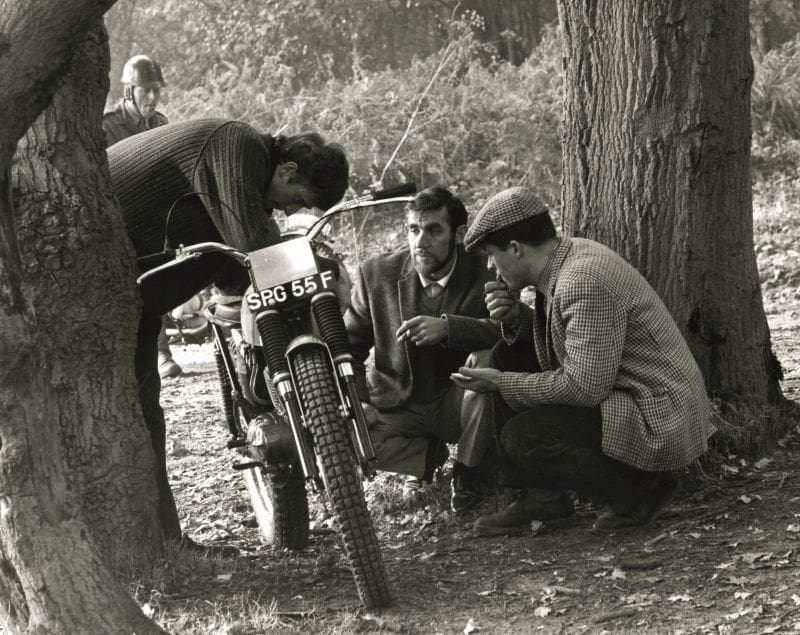
It is easy to say ‘why didn’t they do…’ when talking about the apparent lack of development and missed opportunities of the Sixties British motorcycle industry in general when viewed from a 2022 viewpoint. It has to be remembered the industry had to make a profit and development without eventual reward isn’t always easy to justify. Add in the fact that the market for motorcycles was shrinking as small cars were more affordable than ever – which hit sales of machines traditionally used to power sidecars – and the sporting world was changing too. With urban expansion happening on a large scale, land used for trials was being developed so courses were becoming smaller and the observed trial as a sport was becoming more technical to combat the newer foreign machines coming in. So for BSA this meant their four-stroke machines were fast becoming outdated and in need of some serious development. Yes, the Lampkins were still winning on their C15 models as Arthur and Alan both won the SSDT in the Sixties but as competition manager Brian Martin had realised a few years earlier when the BSA Gold Star was still winning scrambles, it was time to look ahead. For the scrambles effort this meant the unit four-stroke single and an eventual world championship for Jeff Smith but in trials he felt it would be worth looking at the Bantam. He wasn’t alone in this type of thinking as both Comerfords – the big sporting dealers – and Bob Gollner also felt the Bantam would be a worthwhile trials machine after a little development work. It seems as though 1967 was the turning point for this or perhaps a little earlier as the company was still riding high with Alan Lampkin’s win in the Scottish in 1966 but Brian Martin had been doing preliminary work as a feasibility study. In those days the British magazines were quite closely associated with the industry and were often felt to be part of the circle so gained more insight than maybe they would have, or at least when the factories were ready to make announcements they would call. Perhaps this is why, on March 9, 1967 MotorCycle’s man Peter Fraser was pictured in a feature which suggested a works BSA team of Bantams may well be seen in the SSDT.
Enjoying this article? Read plenty more like it with a subscription to Classic Dirt Bike, starting from just £18.99!
In the almost beginning…
If the mid-60s can be seen as the beginning – if not of the Bantam competition story but of the realisation by BSA of the potential their little two-stroke had to fulfil a market need – then it still had to make money or be at least viable for the company to produce. The catalyst for the model Fraser was test-riding came when a promotional film was being made at Hawkstone Park to introduce the Bantam Bushman – a model intended for the sheep stations of Australia – to a wider audience in Australia. Though the machines were the actual stars of the film they had to be ridden and this duty was handled by competitions manager Brian Martin and BSA star rider Jeff Smith. Both riders had a wealth of experience between them in all off-road disciplines and more than a little engineering and development nous. Comparing notes on the day, they realised with a little development the new Bantam model could be a serious contender for the trials market. At under 200lb it was light enough, the wheelbase of under 50in meant it was short enough but could it actually be built into something to compete with the new Spanish machines?
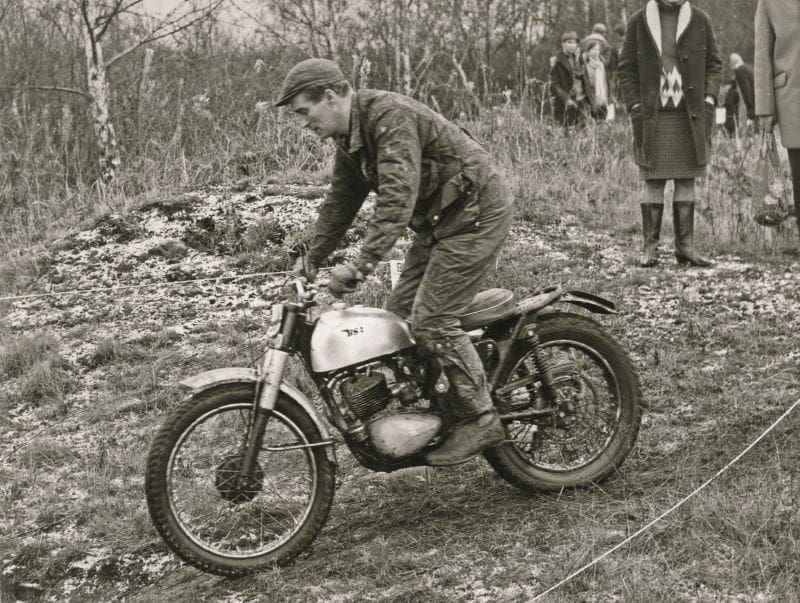
With this food for thought clear in his mind Brian Martin began a feasibility study – and you thought such things were a new idea – to determine the practicalities of the idea. First big step though was the economic viability; such things have to make a profit for the company or why do them? Yes as a one or two-off, or even a factory team of three riders in important events the publicity would be gold dust to a switched-on marketing department but such things are double edged and if a machine is shown to be successful then the public will want to buy one. Heads have to rule hearts and a look through the stock lists of BSA would determine the fate of the idea. The more off-the-shelf bits which could be used then the more chance the resultant machine had to be successful.
With a company the size of BSA and incorporating the Triumph resource as well there were a lot of bits and pieces to go at without producing too many special parts. As he delved deeper into it Brian found the only really special bit needed was a wide ratio gear cluster, the rest of the bits were either BSA Bushman and C15 or Triumph Cub. So, taking the engine, frame, wheels and brakes from the Bushman, allying them to a swinging arm from the Triumph Sports Cub and C15 Trials front forks meant very quickly the concept was up and running. There was a little work done on the engine and Brian Martin proceeded to test the theory in local trials. To quote Peter Fraser “…Brian Martin has been causing raised eyebrows…” which referred to his results in local trials and first class awards in two national trials. Suddenly things looked serious. It helped the cause when BSA fitted proper, or almost proper, trials-sized wheels in the Bushman. With a 4in x 18in rear it meant a proper trials tyre could be used and not sacrifice grip. Up front though BSA fitted the 3in x 20in diameter wheel which the C15T used. Why 20in diameter? According to the publicity for the C15T it was a better general purpose size which floated over rocks more easily… rumour had it the company over-ordered 20in rims and tyres… discuss.

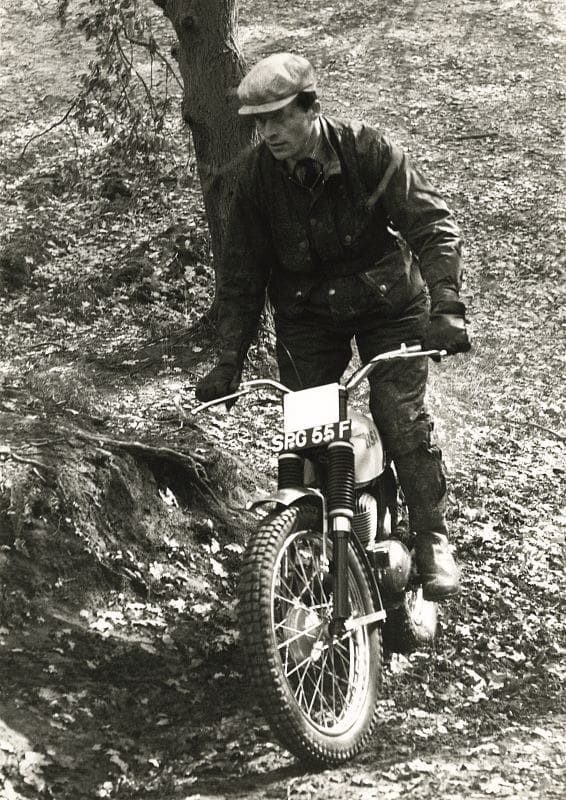
Also from the BSA spares stocks were an Amal Concentric carburettor, an air filter assembly used on the company’s Victor Enduro model and an alloy petrol tank from the C15T. Providing the sparks was an energy transfer ignition – probably a Wico Pacy version as this company provided the Bantam electrics – so no battery or lighting equipment to add weight.
Talking to Fraser, Brian Martin admitted there’d been a little engine work done and there would probably be more to come in this area as he’d co-opted his brother Michael from BSA’s engine development department. Michael was noted for his work with two-stroke engines and would be looking at exhaust development too as the world was realising how important the exhaust system on a two-stroke was to provide the correct performance.
The little prototype was fitted with as wide a ratio gear cluster as was possible which, according to Peter Fraser, meant this was mostly a ‘first gear’ bike in sections unless a flat out blind was required to deal with muddy sections. To jump forward slightly by 50 years, these days a wide cluster isn’t quite so important for Pre65 trials as few events have the high mileage as they did in the Sixties. This allows a lower overall gear ratio and means more gears can be used in sections.
So, on the go, the riding position was described as full size unlike some smaller machines where it is scaled down. Brian Martin quipped the bike was so easy to ride and so light it was likely to give older riders a new lease of life in the sport. Fraser agreed on the lightness of the Bantam and while no one in the development team would be drawn on exactly how light it was, their claim that it was ‘sub-200lb’ felt right to the journalist. Once on the go Peter found the machine responsive and controllable, though said he found the footrest position to be not right for him; qualifying this, he agreed the bike was first of all a prototype and built for someone else.
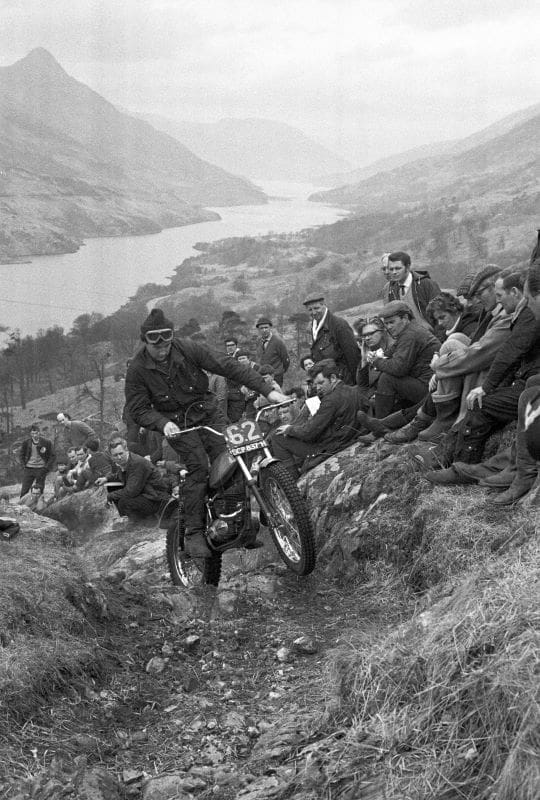
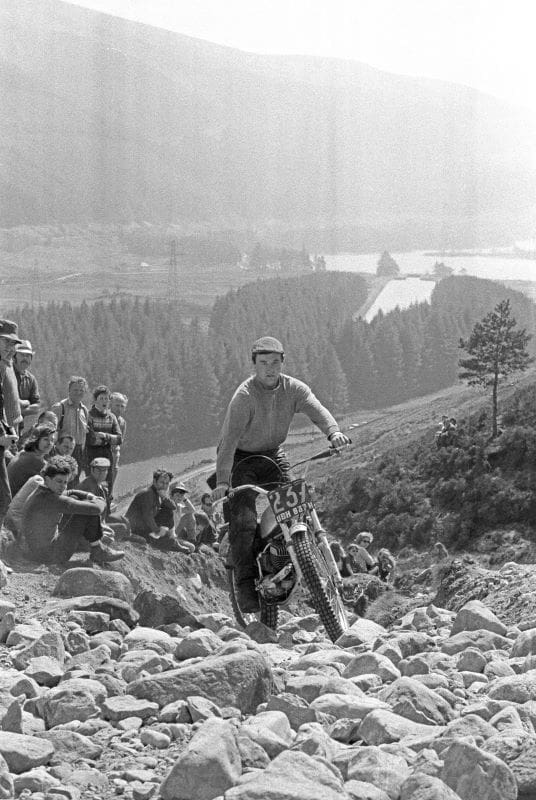
Tackling a steep climb Fraser wound the engine on in deference to the lack of capacity then found as he hurtled up the climb there was no need to use quite so much throttle as the engine pulled quite well from low down. Had the test day been wet things might have been a little different of course but in the bone dry conditions the torque rather than revs could be used. Things Fraser liked were the 11in ground clearance and how the short wheelbase made nadgery sections quite easy. The machine’s performance on downhill sections was commented on as often this type of going can show up weaknesses in a machine yet it was claimed the bike performed just as well here as on climbs. Even allowing for the less than critical type of reporting in those days it was clear this machine had lots of potential and to further test it out a team of three riders – they being Dave Rowland and Mick Bowers on 173cc models and Dave Langston on a 148cc version – would tackle the SSDT later in the year. Peter Fraser had begun his report by saying this machine showed BSA’s long-term interest in the trials scene and finished it off by saying the company certainly were on a winning track with the bike and hoped it would eventually reach production.

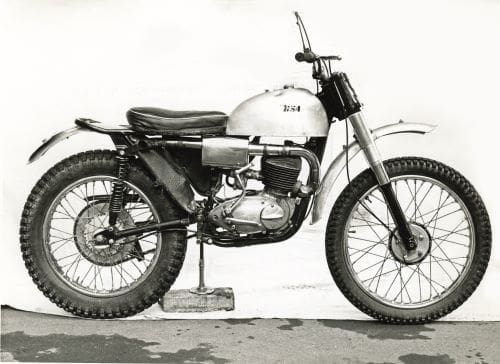
Away from the factory
Just because the factory was hesitant about producing a saleable trials bike from the Bushman version of the Bantam didn’t mean others wouldn’t do it and Comerfords, the sporting dealership in Thames Ditton, Surrey thought the opportunity too good to miss. It didn’t hurt they were probably the most well-known dealership in the competition world and a lot of their employees were involved in the sporting scene in all sorts of disciplines so likely had their ears bent at events. It is also likely Comerfords would do their own ear-bending at BSA, especially after Dave Rowland took his prototype model to second place in the 1967 SSDT. Rowland’s machine would have been similar to the one The MotorCycle featured in March of 1967 and the minimal amount of modification needed to convert the standard Bushman to a more suitable trials spec would have been clear to the team at Comerfords.

So, with BSA not keen on rushing into production Comerfords costed out the idea for themselves to see if it was financially viable. These concerns were even more important for a dealer as they would have to buy the bikes in the first place and even with their trade discount and being able to add a premium to the conversion it could easily mean an uncompetitively priced end product which wouldn’t sell. Peter Fraser was invited along to Comerfords to see what its version of the Bantam was like. With his earlier test of the works model still in mind Peter was shown around the Comerfords version by top trials rider Gordon Farley, who was based at Comerfords and in charge of creating the Bantam for them.
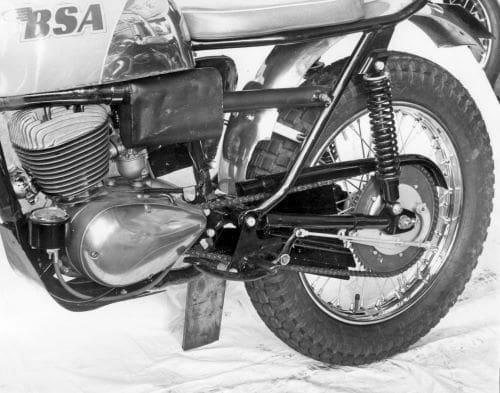
With the benefit of having seen and read about the works effort it was clear what would be needed and the Comerfords spec was similar to the factory prototype. What Farley did was to take the engine, frame, forks and wheels from the standard model, add a Triumph Tiger Cub swinging arm and rear suspension which allowed a 4in wide tyre to be used, then slimmed the subframe a little and had strengthening gussets welded to the steering head to help cope with front end stresses. The centre stand and original footrest mount was removed and the footrests now went on to the pillion rest point. Inside, the engine had a special wide ratio cluster fitted and this was likely the dearest part of the conversion as it required the crankcases to be split and the selector mechanism altered. Once assembled there were light alloy mudguards fitted, a petrol tank from the BSA Victor could be ordered as an option, handlebars were of Sammy Miller pattern and 32in wide. For silencing duty on the upswept exhaust system there was a Peco silencer, developed on a test rig for optimum power.
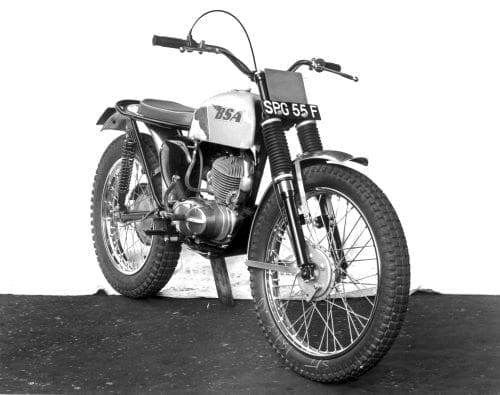
The resulting machine had 101/2in of ground clearance and a 49in wheelbase which Fraser found during his test ride meant there were few obstacles too high and few sections too tight for this ultra-light machine. There was adequate power for most situations from the small capacity engine and even enough power from the engine to use second gear in some situations. Fraser commented there could be situations where the lack of capacity might hamper the machine but felt these would be few and far between for the club rider and in any case the lack of weight of the machine more than compensated for the occasional wanting of power. He summed up with the Bantam being a keen price and ready to go from the off it would find itself in the price range of many a rider. His final sentence of the report appealed to the David and Goliath attitude of riders and he said he could see many riders gaining a level of satisfaction from beating riders mounted on much larger machines.
Born of necessity
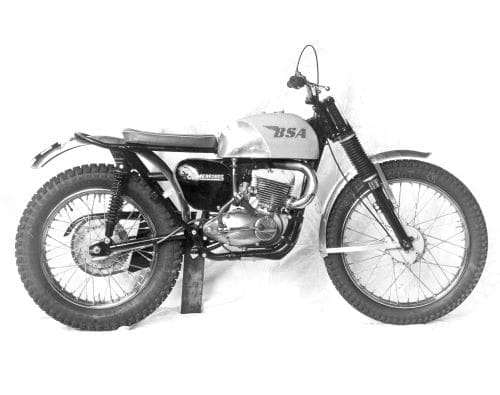
The mainstay of smaller manufacturers was always the Villiers engine and the number of makers who used it in their range was incredible… problem was when NVT decided to stop supplying the market with these engines, such makers were suddenly engineless. In the case of bigger manufacturers such as Dot and Greeves this was really serious and they eventually went foreign for power units. There were repercussions further down the scale, though with smaller production runs it was less of a problem to change tack. Take Bob Gollner for instance: the Hampshire dealer was enjoying success with his own Cheetah range using Villiers engines and even running a supported team of riders but with the supply gone something else had to be done. Along with the rest of the UK trials world Gollner had been impressed by the successes of BSA’s Bantam-mounted works team in the 1967 SSDT and with no Villiers engines likely to be supplied he looked at the Bushman with a view to modifying some for his own purposes. Given where his dealership was based and the sort of terrain anyone buying a bike from him would encounter, Gollner felt anything he created would have to be able to tackle the massive climbs in the national Hoad Trophies Trial. Bob also went against the grain of the time by supplying ready-to-go bikes rather than kit-form machines. There will be readers who remember the tax loophole which meant bikes sold in kit form escaped the purchase tax levied on machines ready to go.
According to the MotorCycle report in December 1969 Gollner reasoned if he could produce a ready-to-go motorcycle which performed well and was cheaper than the Spanish motorcycles then they would sell. It didn’t hurt the project at all to know Gollner had a reputation for producing an excellent product.

So, 1969, BSA had revamped the Bantam engine a little to gain a bit more bottom-end performance and the new Bushman model was as up-to-date as it would get. The motor was deemed good enough to need no more attention than some cleaning up of the ports to remove casting marks otherwise was as standard as it comes. Gollner fitted an upswept exhaust system which tucked in over the top of the engine so the exhaust gases wouldn’t be impeded by dents in the pipe on their way out. At the other end of the in/out process there was a mesh air filter fitted; of Gollner’s own design, this filter tucked up under the seat and ensured the air going into the Amal carburettor was clean and free of grit.
There were some differences between the featured MkII version and Bob’s earlier or MkI version. Though he retained BSA’s main frame and again used a slimmer and lighter subframe of his own making – which was chrome plated to better stand up to the rider’s leg rubbing against the tube – instead of the REH forks on the MkI he used the double damped BSA fork originally made for the C15T. With Gollner’s special subframe in place a rider got a lower seat height and allied to the BSA fork with a 21in rather than a 20in front wheel there was more ground clearance. In the trials world ‘lower and higher’ are two ideals to strive for. The package was finished off with alloy mudguards, folding footrests, trials tyres and trials handlebars though the standard tank was still in place. State-of-the-art three-position Girling dampers took care of the rear end and at 50in the wheelbase was slightly longer than other Bantams on the market.
Unlike other people producing such machines Bob Gollner wasn’t coy about claiming a weight for his Bantam and the tech spec proudly announced it weighed in at 170lb. It is likely a pound or two could be shaved off this if an owner fitted an alloy tank and wheel rims but still 170lb was a really light machine. Jumping on the Bantam for his test ride, Peter Fraser remarked the carburettor needed to be well flooded as there was no air slide to close to aid starting. Carb flooded, the engine fired first kick so clearly the Wipac – Wico Pacy – energy transfer ignition firing through a Femsa coil was up to the job.
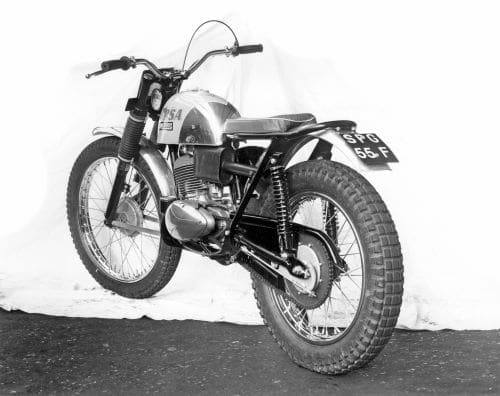
Fraser reported the new engine provided the right sort of power to allow a full range of trials-going to be tackled in bottom gear yet still having enough punch to launch the bike at steep climbs. It was a sign of those times Fraser felt the need to mention the engine two-stroked right the way through the rev-range and it is possible younger readers will not quite be familiar with the affliction ‘four-stroking’ when talking about two-strokes. Modern ignitions and oils have all but eliminated this condition and to be honest I can’t recall the last time I heard a two-stroke engine fire up and run like four-stroke on tickover.


Because Gollner used the standard gears it meant effectively there was only one gear in the four-speed cluster for section use as second gear was too high most of the time. Fraser did say he felt a long, muddy climb could be tackled in second and resulting wheelspin would lessen the effects of over-gearing. On the whole Peter liked the bike, he found its riding position to be excellent and thanks to lack of weight it was very manoeuvrable and little touches such as nylon lined control cables improved the package. He finished off with the bike was likely to find favour with many riders and, as the awards lists were showing, the bike could tackle most things in a trial. It had the advantage of being reliable and should any parts be needed then the local BSA dealer would likely have them in stock.
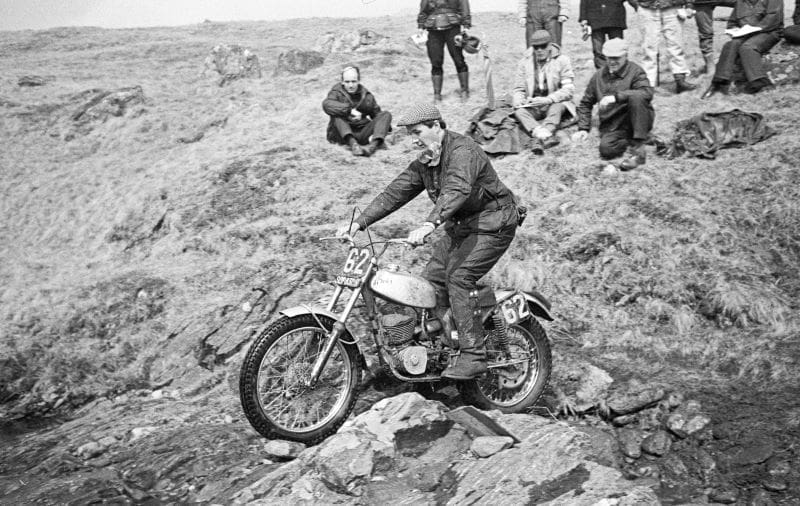
Back at the factory
It is easy to assume while all these dealer-derived models were out there the factory was not doing anything. This would be an incorrect assumption as the late Sixties and early Seventies would show. While BSA may well have been quiet it didn’t mean they were not quietly busy. The Bantam’s performance and popularity was quite obvious to the factory hierarchy as was the realisation something was needed. In the trials world their 250cc C15T was long since out-classed and all of the opposition – be they home or foreign – were using two-stroke power. The biggest thing for BSA was such a company needed volume sales to make a project viable and it was possibly the right time for the company to achieve such sales. With trials being a sport and riders not really needing to use their motorcycle for daily transport coupled with the attitude ‘two-strokes are toy bikes’ finally being disproved then the stage was set for a different kind of competition motorcycle to leave the BSA factory… could it have saved BSA? Who knows but it could have formed part of the comeback and BSA were still actively involved in looking at all sorts of projects with a trials Bantam just being one. Having looked at what was being done outside of the factory BSA began developing their own machine to take on the world. To this end factory rider Mick Bowers was seen out on a very special BSA prototype intended to begin a new era of feet-up success for the BSA company. Ultimately it was not to happen and BSA management decreed the project be closed and all bikes, drawings and the like destroyed… by a complete fluke one bike did escape this fate and can be considered the last genuine ex-BSA works trials bike… CDB checked it out.
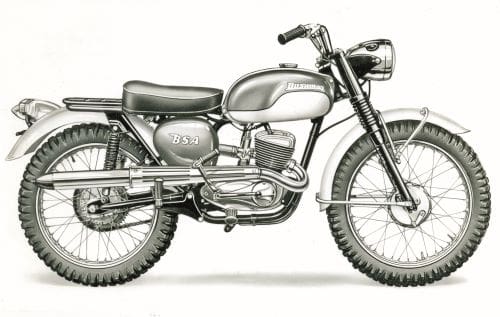
The story goes on
As BSA shelved the Bantam project and first the Spanish, then Italian and Japanese industry took on the trials world it seemed the end for the little stroker then a quirk of fate brought a reprieve. With loads of old bikes lying in sheds all over the country, bikes which were uncompetitive in the modern trials world and belonging to owners who perhaps couldn’t justify the latest machines there came an idea to have events specifically for older, pre-1965 motorcycles. Strictly speaking this new development was for big bikes with separate engines and gearboxes as, at the time, unit engine bikes were classed as lightweights… yes yes I know, try hauling one round the Scottish… As the scene progressed, riders got older and looked for something still ‘classic’ but lighter. Triumph Cubs were in vogue for a while and performed well, as did BSA C15s and so on but still, for ultimate lightness people started looking at BSA Bantams. In their day they went okay but as they’re two-strokes and there’s been 50 years of two-stroke development things have improved beyond BSA’s time. These days in Pre65 trials a BSA Bantam is a respected machine; allied with a Drayton frame, REH forks and rear suspension such as Rockshocks as an example the Bantam is a winner. It still has to be ridden but it can be made to be very successful.


